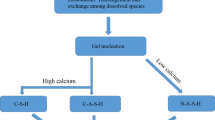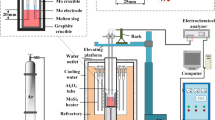Abstract
The present work is devoted to a better insight into the identification of carbonation versus efflorescence formation in alkali-activated blast-furnace slag and investigates the relation between the chemical composition of the alkali-activator and the extent of the occurrence of these two phenomena. Obtained results showed that mixes of relatively lower alkali contents suffer not only from weak compressive strength due microstructural defects, but also from carbonation during the first few days. On the other hand, mixes containing relatively higher alkali contents strongly suffer from efflorescence formation in spite of their interestingly high compressive strengths. Carbonation during the first few days can partially neutralize the alkali content of the surface layers of the material which in turn significantly affects the activation mechanism leading to the formation of binding compounds of different molecular structure.








Similar content being viewed by others
References
Allahverdi A, Hashemi H (2015) Investigating the resistance of alkali-activated slag mortar exposed to magnesium sulfate attack. Int J Civ Eng 13(4 and A):379–387
Allahverdi A, Mahinroosta M (2014) A model for prediction of compressive strength of chemically activated high phosphorous slag content cement. Int J Civ Eng 12(4 and A):481–487
Davidovits J (1991) Geopolymers-inorganic polymeric new materials. J Therm Anal Calorim 37(8):1633–1656
Davidovits J (2008) Geopolymer chemistry and applications. Institute Geopolymere, Saint-Quentine
Provis JL, Duxson P, van Deventer JSJ, Lukey GC (2005) The role of mathematical modeling and gel chemistry in advancing geopolymer technology. Chem Eng Res Des 83:853–860
Duxson P, Lukey GC, Separovic F, Van Deventer JSJ (2005) Effects of alkali cations on aluminum incorporation in geopolymeric gels. Ind Eng Chem Res 44(40):832–839
Lloyd RR, Provis JL, Smeaton KJ, Van Deventer JSJ (2009) Spatial distribution of pores in fly ash-based inorganic polymer gels visualised by wood’s metal intrusion. Microporous Mesoporous Mater 126(1–2):32–39
Najafi Kani E, Allahverdi A (2009) Effects of chemical composition on basic engineering properties of inorganic polymeric binders based on natural pozzolan. Ceram Silik 53(3):195–204
Allahverdi A, Mehrpoor K, Najafi Kani E (2008) Investigating the possibility of utilizing pumice-type natural Pozzolan in production of geopolymer cement. Ceram Silik 52(1):16–23
Škvara F, Kopecký L, Myškova L, Šmilauer V, Alberovska L, Vinšova L (2009) Aluminosilicate polymers—influence of elevated temperatures, efflorescence. Ceram Silik 53(4):276–282
Temuujin J, van Riessen A (2009) Effect of fly ash preliminary calcination on the properties of geopolymer. J Hazard Mater 164(2–3):634–639
Pacheco-Torgal F, Jalali S (2010) Influence of sodium carbonate addition on the thermal reactivity of tungsten mine waste mud based binders. Constr Build Mater 24(1):56–60
Škvara F, Kopecký L, Šmilauer V, Bittnar Z (2009) Material and structural characterization of alkali activated low-calcium brown coal fly ash. J Hazard Mater 168:711–720
Lloyd RR, Provis JL, Van Deventer JSJ (2010) Pore solution composition and alkali diffusion in inorganic polymer cement. Cem Concr Res 40(9):1386–1392
Szklorzova H, Bilek V (2008) Influence of alkali ions in the activator on the performance of alkali-activated mortars. In: Bilek V, Keršner Z (ed) 3rd international symposium on non-traditional cement and concrete, Czech Republic, Brno, 2008, pp 777–784
Škvara F, Pavlasova S, Kopecký L, Myškova L, Alberovska L (2008) High temperature properties of fly ash-based geopolymers. In: Bilek V, Keršner Z (eds) 3rd international symposium on non-traditional cement and concrete. Czech Republic, Brno, pp 741–750
Bortnovsky O, Dědeček J, Tvarůžkova Z, Sobalik Z, Šubrt J (2008) Metal ions as probes for characterization of geopolymer materials. J Am Ceram Soc 1:3052–3057
Najafi Kani E, Allahverdi A, Provis JL (2012) Efflorescence control in geopolymer binders based on natural Pozzolan. Cement Concr Compos 34(1):25–33
Bernal Susan A, de Gutierrez Ruby M, Provis JL (2012) Engineering and durability properties of concretes based on alkali-activated granulated blast furnace slag/metakaolin blends. Constr Build Mater 33:99–108
Häkkinen T (1992) The permeability of high strength blast furnace slag concrete. Nordic Concr Res 11(1):55–66
Häkkinen T (1992) The microstructure of high strength blast furnace slag concrete. Nordic Concr Res 11(1):67–82
Bernal SA, Mejía de Gutierrez R, Pedraza AL, Provis JL, Rodríguez ED, Delvasto S (2011) Effect of binder content on the performance of alkali-activated slag concretes. Cem Concr Res 41(1):1–8
Justnes H, Ardoullie B, Hendrix E, Sellevold EJ, Van Gemert D (1998) The chemical shrinkage of pozzolanic reaction products. In: Malhotra VM (ed) 6th CANMET conference on fly ash, silica fume, slag, and natural pozzolans in concrete, Bangkok, Thailand, pp 191–205
Chen W, Brouwers H (2007) The hydration of slag, Part 1: reaction models for alkali-activated slag. J Mater Sci 42(2):428–443
Lecomte I, Henrist C, Liegeois M, Maseri F, Rulmont A, Cloots R (2006) (Micro)-structural comparison between geopolymers, alkali-activated slag cement and Portland cement. J Eur Ceram Soc 26:3789–3797
Clayden NJ, Esposito S, Aronne A, Pernice P (1991) Solid state 27Al NMR and FTIR study of lanthanum aluminosilicate glasses. J Non Cryst Solids 11:258–268
Ortego JD, Barroeta Y (1991) Leaching effects on silicate polymerization, A FTIR and 29Si NMR study of lead and zinc in Portland cement. Environ Sci Technol 25:1171–1174
Phair JW, Van Deventer JSJ (2002) Effect of the silicate activator pH on the microstructural characteristics of waste-based geopolymers. Int J Miner Process 66:121–143
Swanepoel JC, Strydom CA (2002) Utilisation of fly ash in a geopolymeric material. Appl Geochem 17:1143–1148
Škvara F, Šmilauer V, Hlaváček P, Kopecký L, Cílová Z (2012) A weak alkali bond in (Na, K)–A–S–H gels: evidence from leaching and modeling. Ceram Silik 56(4):374–382
Barbosa VFF, MacKenzie KJD, Thaumaturgo C (2000) Synthesis and characterisation of materials based on inorganic polymers of alumina and silica: sodium polysialate polymers. Int J Inorg Mater 2:309–317
Cloos P, Léonard AJ, Moreau JP, Herbillon A, Fripiat JJ (1969) Structural organization in amorphous silico–aluminas. Clays Clay Miner 17:279–287
Author information
Authors and Affiliations
Corresponding author
Rights and permissions
About this article
Cite this article
Allahverdi, A., Najafi Kani, E. & Shaverdi, B. Carbonation Versus Efflorescence in Alkali-Activated Blast-Furnace Slag in Relation with Chemical Composition of Activator. Int J Civ Eng 15, 565–573 (2017). https://doi.org/10.1007/s40999-017-0225-4
Received:
Revised:
Accepted:
Published:
Issue Date:
DOI: https://doi.org/10.1007/s40999-017-0225-4




